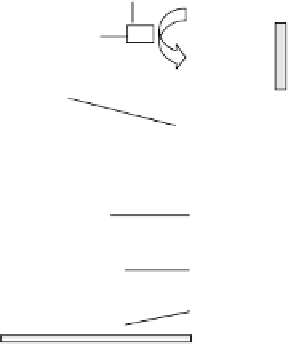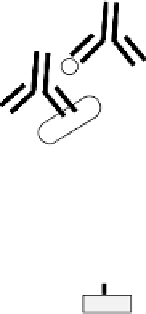Biomedical Engineering Reference
In-Depth Information
Urease
Urea
CO
2
+ NH
3
Electrode
Fluorescence
Analyte
Biotin
Streptavidin
Biotinylated BSA
FIGURE 18.4
Schematics of light-addressable potentiometric sensor
(LAPS). (Adapted from Tu et al. (1999)
J
.
Rapid
Methods Automat
.
Microbiol
. 7: 69-79.)
Nitrocellulose membrane
or
Magnetic bead
nitrocellulose membrane or paramagnetic beads by a capture antibody (Figure 18.4). A flu-
orescent-labeled antibody is allowed to react with the analyte. Antifluorescent antibody
conjugated to urease is then allowed to bind to the fluorescent-labeled antibody, and sub-
sequent exposure to urea (substrate) will result in the production of CO
2
and NH
3
, which
could be detected by an
n
-type silicon semiconductor-based sensor coated with a pH-sen-
sitive insulator (76,77). The magnitude of current generated depends on the potential
across the sensor. Gehring et al. (77) demonstrated that
E. coli
O157:H7 cells could be
detected at 10
4
10
5
cfu/ml of buffer using LAPS. Later, Tu et al. (78,79) used immuno-
magnetic beads to capture and detect
E. coli
O157:H7 at one cfu/g of ground beef after a
6-h enrichment using LAPS. Ercole et al. (80,81) used LAPS to detect
E. coli
from vegeta-
bles; lettuce, sliced carrots, and rucola at 10 cells/ml in 1.5 h in liquid suspension of veg-
etables acted as a bioindicator for possible contamination with pathogens.
A LAPS coupled with a flow-through immunofiltration-enzyme assay system was
developed to provide an indication for the presence or absence of a biothreat agent like
Bacillus
spores rapidly (in 15 min) (82). This has been used in the Biological Integrated
Detection System (BIDS) introduced by the U.S. Department of Defense (DOD) for detec-
tion of biological agents to protect the military from airborne agents.
18.4
Concluding Remarks
We stand at the dawn of the nano biotechnology era. Many biosensor tools show great
promise for the detection of foodborne pathogens and in some cases proof of concept has
been demonstrated. The ruggedness and robustness of these sensors for their ability to
detect pathogens from complex samples like food matrices, environmental swabs, floors,
drains, and water samples must still be examined. In reality, attractiveness and mass
appeal are possible only if they are user-friendly, inexpensive, and made of disposable
materials. Furthermore, the looming threat of bioterrorism appears as a blessing in dis-
guise for the field of biosensor technologies that continue to generate promise and fasci-
nation leading to more support through grants. The progress in this new frontier must be
sustained to continue revolutionizing not only the foodborne pathogen detection in food










